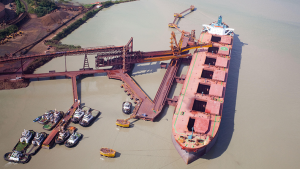Understanding Ship Operational Costs
Operating a ship is inherently expensive, encompassing a broad range of costs that can significantly impact profitability. Key expenses include fuel consumption, crew wages, maintenance, insurance, and port fees. For shipowners and operators, managing these running costs is critical for enhancing profitability while ensuring safety, regulatory compliance, and operational efficiency.
Fuel consumption stands out as one of the largest operating costs for any vessel. The choice of fuel type can dramatically affect overall expenses. Traditional marine fuels, such as Marine Gas Oil (MGO), tend to be more expensive and are subject to fluctuating market prices. In contrast, the adoption of dual-fuel propulsion systems utilizing liquefied natural gas (LNG) can offer substantial savings due to LNG’s lower price point and reduced emissions profile. As regulations become increasingly stringent regarding sulfur oxides (SOx) emissions, switching to cleaner fuels not only helps in compliance but also in reducing long-term operational costs.
Crew wages represent another significant portion of a ship’s operating budget. With the maritime industry facing ongoing challenges related to crew retention and training, shipowners must invest in competitive wages and benefits to attract skilled personnel. Furthermore, ensuring crew members are adequately trained in safety protocols and emergency procedures is essential for minimizing risks and avoiding costly incidents that can arise from human error.
Maintenance costs are also a critical factor in ship operations. Regular maintenance is necessary to ensure that machinery operates efficiently and safely. Neglecting maintenance can lead to breakdowns that not only incur repair costs but also result in costly delays and potential fines for non-compliance with safety regulations. Implementing a proactive maintenance strategy can help mitigate these risks by identifying issues before they escalate into more significant problems.
Insurance costs are another area where shipowners must exercise diligence. The maritime industry is fraught with risks ranging from environmental disasters to piracy. As such, securing comprehensive insurance coverage is essential for protecting assets and ensuring financial stability. However, rising insurance premiums can further strain operating budgets, making it crucial for operators to regularly review their policies and seek competitive rates without compromising coverage quality.
Port fees are often overlooked but can significantly impact overall operating costs. These fees vary widely depending on the port’s location, services provided, and the vessel’s size. Efficient route planning and scheduling can help minimize port fees by avoiding congested ports or selecting more cost-effective docking options.
In conclusion, the multifaceted nature of ship operating costs necessitates a comprehensive approach to financial management within the maritime industry. By focusing on fuel efficiency, crew management, maintenance practices, insurance strategies, and port operations, shipowners can effectively reduce running costs while maintaining high standards of safety and compliance. As the maritime sector continues to evolve amid changing regulations and economic pressures, adopting innovative practices will be vital for enhancing profitability in an increasingly competitive landscape.
Ship running costs refer to the expenses incurred during the regular operation of a vessel. These costs are typically classified into fixed costs (e.g., insurance, crew wages) and variable costs (e.g., fuel, maintenance, port charges). Controlling these expenses requires a multi-faceted approach involving operational, technical, and administrative measures.
Optimizing Fuel Consumption
Fuel accounts for approximately 40-60% of a ship’s operating expenses, making fuel optimization the most impactful strategy for reducing running costs. The following practices can significantly cut fuel consumption:
- Slow Steaming: Reducing the ship’s speed by 10-20% can lower fuel consumption by up to 30%, depending on vessel size and engine type.Example: In 2021, Maersk Line saved millions of dollars by adopting slow steaming across its container fleet, reducing fuel costs and emissions simultaneously.
- Hull Cleaning and Propeller Polishing: Regular maintenance of the ship’s hull and propeller reduces friction and drag, improving fuel efficiency.Case Study: A bulk carrier operating in the Indian Ocean reported a 15% reduction in fuel consumption after undergoing a comprehensive hull cleaning and propeller polishing routine.
- Weather Routing: Modern ships use advanced weather routing systems to optimize routes based on real-time weather conditions, avoiding storms and rough seas.Example: A VLCC tanker navigating the Atlantic Ocean used weather routing software, reducing its voyage time by two days and cutting operational costs by $50,000.
- Engine Load Optimization: Efficient engine load management through automation can prevent fuel wastage. Ships equipped with Engine Performance Monitoring Systems (EPMS) achieve better fuel economy through real-time data analysis.
Improving Maintenance Practices
Preventive maintenance ensures the ship remains operational without unexpected breakdowns that can cause costly downtime. Adopting a Planned Maintenance System (PMS) is essential for long-term cost savings.
- Condition-Based Maintenance (CBM): Instead of following a fixed maintenance schedule, CBM monitors the actual condition of components through sensors, triggering maintenance only when necessary. Example: An LNG carrier using a CBM system reduced engine failure incidents by 25%, saving approximately $200,000 in emergency repair costs over two years.
- Spare Parts Management: Efficient inventory management prevents overstocking or delays caused by a lack of critical spare parts. Just-in-Time (JIT) inventory systems ensure that parts arrive exactly when needed, reducing storage costs.
- Dry-Docking Optimization: Scheduling dry-dock maintenance during non-peak seasons can lead to significant savings due to reduced shipyard congestion and lower service charges.
Crew Cost Management
Managing crew costs is a crucial aspect of operating a ship efficiently, as crew wages and related expenses represent a significant portion of fixed operating costs. While reducing crew numbers may not always be feasible due to regulatory requirements and safety considerations, ship operators can implement several strategic measures to manage these costs effectively without compromising operational efficiency or safety. One effective strategy is the implementation of multi-skilled crew training programs. By providing additional training that enables crew members to handle multiple tasks, ship operators can reduce the need for specialized personnel. This approach not only enhances the versatility of the crew but also fosters a more cohesive working environment where team members are equipped to support one another in various roles. For example, a crew member trained in both engine maintenance and deck operations can fill in as needed, thereby minimizing downtime and ensuring that operational demands are met without the need for additional hires.
Another critical aspect of crew cost management is optimizing crew rotation. Efficient scheduling minimizes overtime costs and ensures that shifts are rotated optimally to prevent fatigue among crew members. By utilizing advanced scheduling software, operators can analyze workloads and adjust rotations accordingly, ensuring that each crew member has adequate rest while maintaining compliance with maritime labor regulations. This not only helps in managing costs but also contributes to the overall well-being and performance of the crew, ultimately enhancing safety on board.
Furthermore, advancements in technology have paved the way for remote support and automation, significantly impacting crew workload and operational efficiency. Modern ships are increasingly equipped with advanced automation systems that allow for remote diagnostics and monitoring of equipment. This technological integration reduces the manual workload on the crew, enabling smaller teams to operate effectively without compromising safety or efficiency. For instance, remote monitoring systems can alert crew members to potential issues before they escalate into serious problems, allowing for timely interventions that prevent costly repairs and downtime.
Optimizing Port and Cargo Operations
Port-related expenses such as berth fees, pilotage, and cargo handling can quickly escalate. Optimizing port and cargo operations is essential for reducing costs and enhancing efficiency in maritime logistics. Port-related expenses, including berth fees, pilotage, and cargo handling, can escalate quickly, impacting overall profitability. To mitigate these costs, ports are increasingly adopting advanced technologies such as automation, IoT, and data analytics. These innovations facilitate real-time decision-making and streamline processes, leading to faster cargo movement and reduced turnaround times. Additionally, implementing effective yard management and collaborative communication among stakeholders ensures that resources are utilized efficiently, minimizing delays. By focusing on these optimization strategies, ports can significantly enhance their operational performance while keeping expenses in check, ultimately benefiting the entire supply chain
Ship operators can adopt these strategies to control port-related costs:
- Efficient Port Turnaround: Minimizing port stay time reduces demurrage charges and port fees. Well-coordinated cargo loading and unloading operations through terminal management systems enable faster port clearance.
- Port Selection and Negotiation: Choosing cost-effective ports with lower fees or entering long-term agreements with port operators can result in considerable savings.
- Cargo Planning and Stowage: Proper cargo distribution ensures the ship maintains optimal stability, reducing fuel consumption and preventing costly load adjustments at sea.
Reducing Insurance Premiums
Insurance premiums depend on a ship’s operational history, safety records, and compliance with international maritime regulations. Shipowners can reduce insurance costs through the following measures:
- Improved Safety Standards: Demonstrating a strong safety culture reduces the likelihood of accidents, lowering claims and insurance premiums. ISM Code Compliance and third-party audits can strengthen safety credentials.
- Fleet Digitalization: Installing telematics systems and data-driven risk management tools allows insurers to assess risk more accurately, offering lower premiums for ships with excellent operational records.
- Claims Management: Avoiding frequent insurance claims by maintaining robust operational procedures prevents premium increases during policy renewals.
Adopting Energy-Efficient Technologies
Technological innovation plays a crucial role in reducing ship operating costs. Investing in energy-efficient systems and modern ship designs can generate long-term savings.
- Hybrid Propulsion Systems: Modern vessels equipped with hybrid propulsion systems that use dual-fuel engines or battery storage can reduce fuel consumption significantly.
- Eco-Friendly Hull Coatings: Advanced hull coatings such as Silicone-Based Antifouling Paints minimize biofouling, improving hydrodynamic performance and reducing drag.
- Waste Heat Recovery Systems: Ships can use waste heat from engine exhausts to generate additional power, cutting energy costs by up to 10%.
- Renewable Energy Integration: Emerging technologies like solar panels and wind-assisted propulsion systems are being adopted to reduce fuel dependency and operational expenses.
Leveraging Digitalization and Automation
The adoption of Maritime 4.0 technologies has revolutionized ship cost management by leveraging data-driven decision-making, predictive maintenance, and automated operational control. Centralized fleet management platforms provide real-time tracking, operational reporting, and performance optimization, allowing for more efficient oversight of maritime operations. Advanced analytics and artificial intelligence (AI) play a crucial role in predicting maintenance needs, optimizing routes, and analyzing fuel consumption trends, which enables proactive cost reduction. Although still in the development phase, autonomous shipping technology holds the promise of significantly reducing crew-related costs, lowering fuel consumption, and minimizing operational errors, further enhancing the efficiency of maritime logistics.
Case Study: Cost Reduction in Action
A global shipping company managing a fleet of 150 bulk carriers implemented a comprehensive cost-reduction strategy that included slow steaming, data-driven maintenance, and hull optimization. Over three years, the company reported:
- Fuel Savings: $50 million due to speed reduction and route optimization.
- Maintenance Savings: $10 million through predictive maintenance using IoT sensors.
- Insurance Premium Reduction: 15% decrease in premiums due to a zero-incident record.
- Port Fee Savings: $5 million saved through long-term port agreements and efficient cargo management.

Reducing ship running costs requires a strategic, multi-layered approach that balances operational efficiency, regulatory compliance, and technological investment. From fuel management and crew optimization to maintenance and insurance savings, shipowners must implement best practices supported by modern technologies and real-time data. While some measures, such as adopting energy-efficient technologies, involve upfront investment, the long-term savings can be substantial. The global shipping industry’s push toward sustainability and operational efficiency ensures that reducing running costs remains a top priority for ship operators worldwide.



